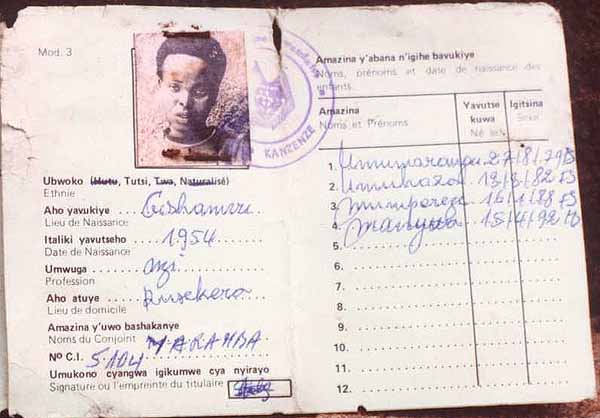
 |
Rwanda - - - Name and Document
form: Carte d'identité,
National ID card; Year established: 1933, 1962; Status: discontinued in 1996.
Categories and groups : "Ethnicity"
("Ubwoko" in Kinyarwanda and "Ethnie" in French) appeared immediately beneath
the cardbearer's photograph as the uppermost item on page two of the Rwandan
ID card. Four possible "ethnic" categories appeared with the issuing
official striking a line through all but the applicable category, for example
"Ubwoko (Hutu , Tutsi, Twa, Naturalisé)"
. The term "Naturalisé"
applied to naturalized citizens. Because the cardbearer's name appeared on page
one, the name could not be seen together with the photograph and ethnicity,
except by turning back to the first page. Below the ethnicity entry pages 2
and 3 of the card included entries for place of birth, date of birth, profession,
place of issue, name of spouse, signature of the issuing official and the names
and birth dates of up to 12 children. The ethnicity item on the ID card first
appeared on ID cards issued by Belgian colonial authorities after 1933. The
entry for ethnicity on ID cards was retained after Independence in 1962. Before
April 1994, about 85% of the population were Hutu, 14% Tutsi, and less than
1% Batwa (Twa). Scholars suggest that prior to the rigid Belgian classification
system imposed after 1926 on Rwandans through ID cards, the census and in employment
and education quotas, the Hutu and Tutsi could better have best been described
as social caste groups and not separate ethnic groups. Hutus and Tutsis in Rwanda
share a common language and religious affiliations. Physical differences sometimes
exist, but not always. Intermarriage between the groups has always occurred
with some frequency. After the genocide, new cards were issued without the ethnic
entry (new residency cards in 1995 and new National ID cards in 1996).
Comments: In July 1991, NGOs strongly recommended removal of ethnicity
from ID cards. Article 16 of the
August 1993 Arusha Accords also required this action by the projected transitional
government. ID cards were used to identify Tutsi victims for death during the
1994 genocide.